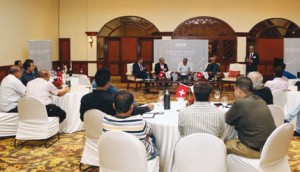 India’s textile producers have a clear picture of the challenges they face, and a determination to make the improvements needed along the pathways to future prosperity. That was the message from the three-day USTER® QUALITY UNIVERSITY 2014 event, held in Goa recently.
India’s textile producers have a clear picture of the challenges they face, and a determination to make the improvements needed along the pathways to future prosperity. That was the message from the three-day USTER® QUALITY UNIVERSITY 2014 event, held in Goa recently.
The industry is crucial to the national economy and cotton is the dominant fiber. With activities across the entire textile value chain, India is focused on improving competitiveness through economies of scale and quality-enhancing measures from cotton field to finished fabric. Special attention is aimed at raw cotton harvesting and ginning, to reduce contamination. Greater automation in manufacturing, increased use of yarn quality control technology and international market targeting are among key priorities. USTER’s second Quality University attracted 24 high-level participants, including owners and directors of 19 mills from Gujarat, one of India’s most important textile regions. The theme of the event, from December 5 to 7, was ‘Opportunities and challenges for the Indian textile industry’. Delegates discussed the major issues for the industry’s future prosperity, with a panel of experts offering valuable insights.
Multi-faceted improvement plans
The panel, invited by Uster Technologies, Switzerland and its Indian office, comprised: Dr. Anil K. Sharma, Director Ahmedabad Textile Industries Research Association (ATIRA); Ashok K. Sharma, Director Alliance Technocrats Pvt. Ltd.; Kaushik Dave, Managing Director Gujarat Hyspin Pvt. Ltd.; and Thomas Nasiou, head of textile technology at Uster Technologies. The discussions were moderated by V.R. Rathnam, Head Uster Technologies India. Panelists outlined their views on raw material issues, manufacturing and yarn trends. Rather than one major problem, the areas acknowledged as requiring improvement cover several aspects of the industry’s activities, and a number of projects are already tackling some of these. Even in an age ruled by technology, it was stressed that human factors were still critical for success in Indian textiles
Challenges along the entire value chain
India covers every stage of the textile value chain, providing employment for a large share of the nation’s total labor force. Cotton is sure to remain the most important fiber, and the large cotton-growing capacity in India forms a solid basis for the entire sector’s success on global markets. But there should be increased efforts to use this strength as part of an added-value campaign spanning the whole industry, with an emphasis on quality and increased investments in downstream processes such as knitting and finishing. In this way, the industry would achieve greater economies of scale and improve its overall competitiveness internationally.
Tackling cotton contamination
By far the biggest negative for the image of Indian cotton is the continuing problem of contamination, and this topic was discussed extensively at the Quality University. Ginning is only part of the story, but quality here is still falling short of the standards required by spinners. India has more ginning capacity than the industry needs, and even a renewed focus on quality in recent years has made little impact so far. As industry insiders know only too well, trash content has actually been increasing. This tends to lead to lower prices for both the raw cotton and the yarns made from it, and spinners are desperate for a solution, even if it means paying more to the gins for cleaner cottons. India also has some specific issues, arising from the nature and size of the cotton fields, which make machine-harvesting difficult or impossible in many cases. Hand-picked cotton has the potential for better quality, but often the pickers are unaware of the correct segregation and storage routines to avoid unwanted mixing and contamination. The good news is that significant improvements are achievable, from picking to ginning, with proper attention, training and consultation. Examples have shown that real improvements are possible as the spinners’ requirements are better understood and implemented – but it will take time.
Automation – and human skill shortages
Even mills with the latest machinery and quality control instruments installed will find manufacturing challenging. People are at the root of the problem, as skilled labor is scarce. Panelists at the Quality University mentioned skill development initiatives coming from the government, although implementation is taking time. Developing the entire value chain is important. At the moment there are gaps in fabric production, processing and garment making, while spinning has large capacities. Each stage in the production chain must work in unison to achieve consistent quality – which is still a big issue.
A look into the future – yarn trends
Yarn buyers are increasingly demanding lower values for imperfections, contamination, CLASSIMAT® faults and strength CV. These parameters are the starting point for quality. Trends show that coarse and medium counts from Ne 26 to Ne 40 will be most important in future. Knitting yarns are also attracting greater demand, especially compact core yarns. Looking at the competitive advantages and strengths of the Gujarat textile producers in global markets, the panel highlighted the situation in China. Spinning in the People’s Republic is upgrading, but struggling with high costs, so the mills are aiming at higher value yarn production. Turkey and Vietnam were also identified as important yarn-producing countries. Competing with these three major producers would be an opportunity for the future, supported by the textile understanding and entrepreneurial skills of the Indian textile manufacturers. The expert panelists also proposed that India should maximize the market appeal of S6 cotton and yarn – premium products from Gujarat – through a special branding campaign.
Vital interface: management and technical expertise
Delegates at the USTER® QUALITY UNIVERSITY took the many opportunities for networking and expert discussions to benchmark their own business and technical operations against best practice – and to explore their improvement potential. The spinners from Gujarat were able to hear special presentations on spinning mill management with quality in mind, with special emphasis on improving profitability and optimizing quality. Practical examples of how these guidelines work in mill processes from bale through to winding complemented these presentations, alongside the panel discussions and interactive sessions focused on the specific needs of the participating mills. The delegates welcomed the chance for face-to-face meetings with some of the sector’s most influential and knowledgeable figures, helping to extend their own business expertise and confidence. Thomas Nasiou, head of textile technology at Uster Technologies, summarized the aims and outcomes of the event: “Our objective with the second USTER® QUALITY UNIVERSITY was to share what it means to run a spinning mill with a quality mindset, to achieve optimum results in both profitability and quality. Interacting with experts in the panel discussions and discuss experiences and best practices of spinning mills from around the globe was certainly a most valuable and well appreciated way of doing that.”
 Tekstil Teknik Dergisi Tekstil Haberleri, Tekstil Sektörü, Tekstil Teknik
Tekstil Teknik Dergisi Tekstil Haberleri, Tekstil Sektörü, Tekstil Teknik




